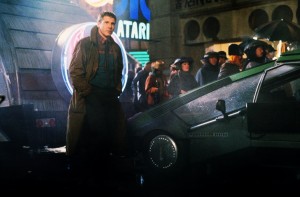Review by Tyrell Corporation prototype Aaron Vehling
I was drinking at a bar in my neighborhood one night when a woman who might be a highly sophisticated, genetically engineered cyborg (no spoilers) took my IPA out of my hand, drank some of it, and then asked if she could have my beer. Now, in real life Sean Young is not even remotely anything but an organic woman, but in Ridley Scott’s 1982 film Blade Runner, she plays one of the most famous characters in film in which such questions are necessary.
Blade Runner, which also stars Harrison Ford, Rutger Hauer, Darryl Hannah, and Edward James Olmos, among others, is the perfect blend of sci-fi, film noir, and philosophy piece that has been copied immensely since its initial, unsuccessful theatrical run. It’s got a neo-noir soul packed in an action-film cover. It raises questions about the nature of humanity, the self, and existence that are comfortable in a Terrence Malick film, while injecting enough action tropes to make us forget that fact.
Panned in its day and re-edited once its cult status became enshrined, now it’s the most natural of sci-fi films against which sci-fi films are judged. Most future adaptations of Philip K. Dick books — this film was the first adaptation of a Dick book, namely Do Androids Dream of Electric Sheep? — take their cues from this one.
Films like Minority Report and Total Recall, both based on Dick stories, took the essence of their source material and modified it in a way that not only represents the ideal way to carry out such a task, but also the best way for any screen adaptation to take place.
It’s loosely like the difference in reincarnation theories in Hinduism and Theravada Buddhism — in the former the bulk of the personality carries over into the next life and in the latter only the very basic traits carry over, like one candle lighting another candle. So too with the typical interpretation of a Dick book: Some of the elements don’t remain, such as the collectivist Mercerism cult of Sheep, or the superfluous space-travel talk of Minority Report, but the core elements that make it Dickian remain: The depth and breadth of the characters and the very basic concerns those characters have. There’s not a lot of high-minded technobabble occurring. These are people stories with a sci-fi dressing, and not the other way around.
The sci-fi-infused films that aren’t based on Dick books can seem like it because of the strong influence of Blade Runner, regardless of the merits of the project. Masterpiece Dark City, The Fifth Element and even Judge Dredd (the one with Sly), all owe their depictions of massive, sky-high futuristic cities to Blade Runner’s depiction of a dystopian future of a city alight in massive skyscrapers, some aerial vehicles, and a darkness filled with the unsavory and the robotic. Dark City even owes its lightless moodscapes and Wilderesque overtones to Blade Runner. The meditations on humanity and all of that come into play fairly quickly in the movie.
In 2019, the so-called replicants, cyborgs that are virtually indistinguishable from humans, are not actually allowed on Earth. They’re relegated to doing menial or dangerous work in colonies on other planets. But the Nexus-6 models, although they lack empathy, they have all the other necessary feelings we humans deal with in various ways: desire, need, umbrage, attachment. They look and feel like humans as well. So cognizant are they of their fates that four of them escaped to Earth in a bid to extend their four-year lifespan. It’s up to washed-up “Blade Runner” (replicant bounty hunter) Rick Deckard (Ford) to track them down and “retire” them.
There are a lot of questions that come up throughout the plot, but in some respects it’s best to leave that to you to go see the film. Spoilers abound in trying relay the questions posed along the way as Deckard picks off the replicants one-by-one. Some of the biggest questions arise with Rachel (Young), the love interest of Deckard who proves that sometimes we don’t know ourselves and that the events of the past that we believe have shaped us into our current and future selves are not at all what we always thought they were.
I can’t proceed without mentioning that Vangelis’ brilliantly dark and emotive synthesizer-laden soundtrack is among the real stars of this film. Along with the work of John Carpenter, elements of this soundtrack ensured that years later everything from the soundtrack to Drive and several TV shows would incorporate the dissonant and gorgeous minimalism of moody synths. –Aaron Vehling
Aaron Vehling operates the music blog Vehlinggo.com, in which he genuflects several times a week toward Italo Disco, synthwave, house, and all that other stuff that makes you dance, cry, and fall in love. He digs the music of the Valerie Collective and Johnny Jewel and the films of Lars von Trier and Nicolas Winding Refn. Though he’s from Minneapolis, he now lives in Harlem, New York, on the same block as the mansion from The Royal Tenenbaums.
BLADE RUNNER screens Friday and Saturday, April 10 and 11, at 7:00 and 9:30, and Sunday, April 12, at 5:00 and 7:30 at the Trylon. Note: there will also be a special book club screening of the film Saturday, April 11 at 10:00 am, followed by a discussion of the film and Philip K. Dick’s novel Do Androids Dream of Electric Sheep? around the corner at Moon Palace Books. Advance tickets for all shows are $8.00 and you can purchase them here.

